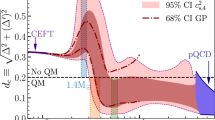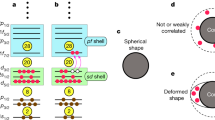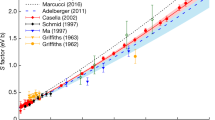Abstract
The exergy1 of a physical system is the maximum amount of mechanical work that can be extracted from that system so that a system in thermodynamic equilibrium has zero exergy. An old theme in cosmic thermodynamics is that the second law implies that the Universe is running down (running out of exergy) and approaching thermodynamic equilibrium, ‘heat death’. However, in the standard model of the early Universe2, at 0.01 s after the big bang the Universe consisted of ordinary matter (nucleons), electrons and positrons, neutrinos, photons and gravitons. The gravitons were decoupled, but the others were in thermodyamic equilibrium. Thus the Universe had already reached the state of heat death, and its exergy was zero. The main problem is, therefore, not to describe the running-down of the Universe, but to understand its revival. When and how was exergy created, in particular the nuclear exergy, which is transformed into life-supporting light in our Sun? We have studied a model which should represent the nucleon gas of the early Universe quite well. We find that the main creation of nuclear exergy started around 10 s after the big bang, and most of the exergy was created during the first few minutes, 85% during the first hour, and that the process was essentially completed during the first 24 h. The final value of the exergy was 7.72 MeV per nucleon. The consumption of this exergy started much later and takes place in the stars over a time scale of hundreds and thousands of millions of years.
This is a preview of subscription content, access via your institution
Access options
Subscribe to this journal
Receive 51 print issues and online access
$199.00 per year
only $3.90 per issue
Buy this article
- Purchase on Springer Link
- Instant access to full article PDF
Prices may be subject to local taxes which are calculated during checkout
Similar content being viewed by others
References
Rant, Z. Forsch. Geb. IngWes. 22, 36 (1956).
Weinberg, S. Gravitation and Cosmology: Principles and Applications of the General Theory of Relativity (Wiley, New York, 1972).
Tolman, R. C. Relativity, Thermodynamics and Cosmology (Oxford University Press, 1934).
Layzer, D. Scient. Am. 233, 56 (1975).
Landsberg, P. Thermodynamics and Statistical Mechanics, 233, 366–367 (Oxford University Press, 1978).
Baehr, H. D. Energie und Exergie (VDI, Düsseldorf, 1965).
Tribus, M., Shannon, P. T. & Evans, R. B. Am. Inst. Chem. Engng J. 12, 244 (1966).
Evans, R. B. thesis, Dartmouth College, Hannover, New Hampshire (1969).
Tribus, M. & McIrvine, E. C. Scient. Am. 225, 179 (1971).
Evans, R. B. in The Maximum Entropy Formalism; 15 (eds Levine, R. D. & Tribus, M.) (MIT Press, 1979).
Kullback, S. Information Theory and Statistics (Wiley, New York, 1959).
Fry, J. N., Olive, K. A. & Turner, M. S. Phys. Rev. D22, 2953 (1980); D22, 2977 (1980).
Kolb, E. W. & Wolfram, S. Phys. Lett. 91B, 217 (1980); Nucl. Phys. B172, 224 (1980).
Olive, K. A., Schramm, D. N., Steigman, G., Turner, M. S. & Yang, J. Astrophys. J. 246, 557 (1981).
Peebles, P. J. Astrophys. J. 146, 542 (1966).
Wagoner, R. V., Fowler, W. A. & Hoyle, F. Astrophys. J. 148, 3 (1967).
Schramm, D. N. & Wagoner, R. V. A. Rev. nucl. Sci. 27, 37 (1977).
Dyson, F. J. Scient. Am. 225, 50 (1971).
Landau, L. D. & Lifschitz, E. M. Statistical Physics, 340–343 (Pergamon, Oxford, 1959).
Hoyle, F. & Fowler, W. Nature 197, 533 (1963).
Langacker, P. Phys. Rep. 72, 187 (1981).
Sakharov, A. JETP Lett. 5, 24 (1967).
Yoshimura, M. Phys. Rev. Lett. 41, 281 (1978).
Ignatiev, A., Kranikov, N., Kuzmin, V. & Tankhelidze, A. Phys. Lett. 76B, 436 (1978).
Dimopoulos, S. & Susskind, L. Phys. Rev. D18, 4500 (1979).
Ellis, J., Gaillard, M. K. & Nanopoulos, D. V. Phys. Lett. 80B, 360 (1978); 82B, 464 (1979).
Weinberg, S. Phys. Rev. Lett. 42, 850 (1979).
Toussaint, D., Treiman, S. B., Wilczek, F. & Zee, A. Phys. Rev. D19, 1036 (1979).
Nonopoulos, D. V. & Wienberg, S. Phys. Rev. D20, 2484 (1979).
Kolb, E. W. & Wolfram, S. Phys. Lett. 91B, 217 (1980).
Ellis, J., Gaillard, M. K., Nanopoulos, N. V. & Rudaz, S. Nucl. Phys. B176, 61 (1980).
Author information
Authors and Affiliations
Rights and permissions
About this article
Cite this article
Eriksson, KE., Islam, S. & Skagerstam, BS. A model for the cosmic creation of nuclear exergy. Nature 296, 540–542 (1982). https://doi.org/10.1038/296540a0
Received:
Accepted:
Published:
Issue Date:
DOI: https://doi.org/10.1038/296540a0
This article is cited by
Comments
By submitting a comment you agree to abide by our Terms and Community Guidelines. If you find something abusive or that does not comply with our terms or guidelines please flag it as inappropriate.



